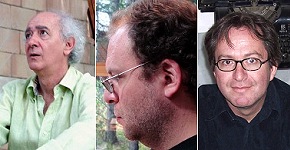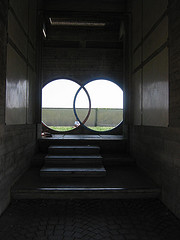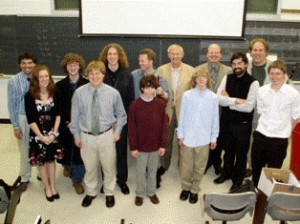Sequenza21 blogger Charles Griffin is having the World Premiere of his Concerto for Chamber Orchestra on May 3 by the Westchester Chamber Orchestra. The concert is scheduled to begin at 8 pm at Christopher J. Murphy Auditorium in the Murphy Science Building, corner of Summit and North Avenues, on the campus of Iona College in New Rochelle. There is a short conversation between the composer and WCO Artistic Director Barry Hoffman here.
In another part of the forest, Aguavá New Music Studio, run by our amigos conductor Carmen-Helena Téllez, composer Cary Boyce and flutist/producer Alain Barker, are staging a concert called Of Love and Courage at 8 pm on May 8 at Williams College. The concert will be selected from works by Louis Andriessen, Cary Boyce, George Crumb, Geoffrey Gordon, Larry Polansky, Antonio Borges Cunha, Kaija Saariaho, and Carmen-Helena Téllez. The concert also features a new work especially composed for the group by faculty member Ileana Pérez-Velázquez.
Here’s a sample from Aguavá’s educational project with Indiana University’s young Contemporary Vocal Ensemble.
[youtube]ZSrqpDAOcy4[/youtube]
[youtube]ZViZUoJwH-w[/youtube]
Not really a religious piece but makes even a good atheist like me tear up. The Protecting Veil is Tavener’s masterpiece but as short pieces go, this one is special. Who has recommendations for other Orthodox Easter listening?
Wilfrido Terrazas, phenomenal flautist and busy-busy beaver in the Mexican new-music scene, just passed along notice about a fantastic series of concerts coming up the start of next month in NYC.
3G: Tres Generaciones Music Festival May 2–7
 The International Contemporary Ensemble (ICE) hosts a celebration of composer Julio Estrada and three generations of New Music from Mexico. This May 2–7, ICE invites New Yorkers to partake in a trailblazing cultural exchange when it hosts this six-day celebration of avant-garde music from Mexico. The Festival will showcase the work of three generations of Mexican composers: esteemed musical pioneer Julio Estrada; the second generation, his celebrated mid-career students Germán Romero and Ignacio Baca Lobera; and 10 up-and-coming composers, all of whom have studied with or have been influenced by the three masters.
The International Contemporary Ensemble (ICE) hosts a celebration of composer Julio Estrada and three generations of New Music from Mexico. This May 2–7, ICE invites New Yorkers to partake in a trailblazing cultural exchange when it hosts this six-day celebration of avant-garde music from Mexico. The Festival will showcase the work of three generations of Mexican composers: esteemed musical pioneer Julio Estrada; the second generation, his celebrated mid-career students Germán Romero and Ignacio Baca Lobera; and 10 up-and-coming composers, all of whom have studied with or have been influenced by the three masters.
The up-and-comers include Marisol Jiménez, Víctor Ibarra, Iván Naranjo, Hiram Navarrete, Mauricio Rodríguez, Juan José Barcenas, José Luis Hurtado, Edgar Guzmán, Víctor Adán, Sandra Lemus, Wilfrido Terrazas; most I’ve heard and can tell you they’re an exciting and creative bunch.
Visit the ICE website for full concert details. All but one of the four concerts are free, to boot, so money can’t be your excuse. This is going to be good, got it?
No longer so newlywed Molly Sheridan has a new baby…well, actually, it’s a blog, but it’s almost the same thing. Check it out.
Today is National Record Store Day. Music sellers throughout the country are celebrating in a variety of ways, from special sales and promotions to instore performances. Given the challenges that have faced “brick and mortar” record stores in recent years – internet retailers, digital downloading, and plummeting CD sales among them – I’m glad there’s a day to celebrate with the people who’ve helped me find many musical treasures. To find out if your local retailer is participating, visit www.recordstoreday.com.
by Patrick Durek
Since its inception in 1985, Cygnus Ensemble has been at the forefront of chamber groups dedicated to expanding the repertory. Generating works for subsets of its unorthodox instrumentation—two guitars, cello, oboe, flute, and violin—has been its primary mission, and while premieres by well-known composers (Charles Wuorinen, Meyer Kupferman, and Milton Babbitt) have been given, it is the group’s championing of works by up-and-coming composers that has perhaps been most significant. Robert Martin, Jonathan Dawe, and Robert Pollock have all written multiple works for Cygnus Ensemble and are now firmly rooted in the Northeastern milieu that Wuorinen, Kupferman, and Babbitt had for so long dominated.
The group has a dynamic that has, for the past two decades, given it a credence that many other new music ensembles lack, making it an attractive premiere-vehicle for the established composer and a coveted marketing entity for the aspiring composer. Part of this dynamic is created by impeccable musicianship: each member not only possesses mastery over his or her instrument, but a depth of experience performing new music. Another element has been the ensemble’s willingness to experiment with different modes of advertising and programming.
Cygnus Ensemble is, ironically, both traditional (it typically eschews the now ubiquitous attention-grabbing concerts that incorporate dance, poetry, costumes, and slide shows; it usually gives evening concerts at established classical music bastions such as Merkin Concert Hall and Symphony Space), and progressive (it is not uncommon for a concert to feature works solely by esoteric composers—no traditional music thrown in for sweetening effect). It might sound as if Cygnus Ensemble caters to connoisseurs of the avant-garde, composers, and musicologists. And it does. But it also fills seats: their last concert, at Weill Hall, on March 8, sold out. The secret ingredient? In part, an embrace of Internet technology.
William Anderson, Cygnus Ensemble’s founder and guitarist, explains the group’s success as a result of outreach via new media. “Most groups just try to get composers to come,” he says. “We have advertised extensively, directing traditional listeners to our Web site, where they can listen to sound clips, watch videos, and hear interviews. Outlets such as YouTube give the ticket-buying public a new point-of-entry into a new work.”
 Cygnus Ensemble’s upcoming concert, at Merkin Concert Hall, on April 23, at 8 pm, features new works by Yehudi Wyner, Harold Meltzer, Mario Davidovsky, and Chester Biscardi. Such a program might frighten the non-new music fanatic, but it doesn’t have to. A tentative but curious music aficionado can visit cygnusensemble.com, and get acquainted with the composers and their works. One might be surprised to learn, for instance, that both Yehudi Wyner and Mario Davidovsky are recipients of Pulitzer Prizes for Music, or that the feature work, Brion, by Harold Meltzer, was inspired by a visit to the Brion-Vega Cemetery, in San Vito d’Altivole, Italy. (A viewing of the YouTube Cemetery Tour, coupled with the accompanying sound clips of both the piece and Meltzer’s verbal descriptions, makes one eager to see the performance of the entire work.)
Cygnus Ensemble’s upcoming concert, at Merkin Concert Hall, on April 23, at 8 pm, features new works by Yehudi Wyner, Harold Meltzer, Mario Davidovsky, and Chester Biscardi. Such a program might frighten the non-new music fanatic, but it doesn’t have to. A tentative but curious music aficionado can visit cygnusensemble.com, and get acquainted with the composers and their works. One might be surprised to learn, for instance, that both Yehudi Wyner and Mario Davidovsky are recipients of Pulitzer Prizes for Music, or that the feature work, Brion, by Harold Meltzer, was inspired by a visit to the Brion-Vega Cemetery, in San Vito d’Altivole, Italy. (A viewing of the YouTube Cemetery Tour, coupled with the accompanying sound clips of both the piece and Meltzer’s verbal descriptions, makes one eager to see the performance of the entire work.)
Designed by the sculptor/designer Carlo Scarpa, Brion-Vega is an eerily austere memorial that juxtaposes large, cold concrete tombs with placid reflecting pools and meticulously manicured lawns. “Seemingly incongruous elements,” as Meltzer notes, “come together to create a sense of peace.” In Brion the musical work, flute (doubling piccolo), oboe, guitar, mandolin, violin, and cello (the instruments themselves also apparently unrelated), engage in a sonic intertwining that ultimately leads to unity. Without the aid of Carlo Scarpa’s Brion YouTube tour, the Brion photographs, and the sound clips, one might have no idea what Brion was. The tendency for all but the most daring would be to skip the Cygnus Ensemble concert in favor of something known. For all the quibbling about Internet technology building a wall around us, there can be no mistake about its potential for elucidating new art for the public.
In addition to Brion, the April 23 concert will include Chester Biscardi’s Traverso, for flute and piano; Romancero, for soprano, flute, clarinet, violin, and cello, which uses anonymous texts by Jewish Sephardim; and Oboe Quartet, by Yehudi Wyner. On the surface, the program appears to be, as Anderson confesses, “more like a new music ghetto program.” However, each work has the potential to be grasped and appreciated by traditional classical music listeners. “Oboe Quartet is sumptuous and will appeal to the Brahms lovers. I think it’s as convincing [as Brahms], but in a new voice.”
Perhaps the salient musical element that unifies the program is the tonal triad. Serving as the sunlight that draws together the tombs, grasses, and waters of Brion-Vega, the triad makes several unexpected appearances in both Brion and Oboe Quartet, shining light on what otherwise might be construed as esoteric avant-garde. “The way everything coalesces around them is striking.” Anderson emphasizes. “I think of these triads as iconic, as uniting all of us. They are fleeting but the impression is there.”
Anybody seen the new Met production of Satyagraha?
[youtube]sMtDI539bvI[/youtube]
 Usually, when thinking of contemporary classical music, one thinks of the rather abstract and cerebral music of the decade right after the Second World War. Some of this so-called serial music in my opinion is very exciting, sometimes purely beautiful, and sometimes incomprehensible. However, one cannot deny that, for the listener, there seem very few similarities or references to any other kind of music, making it hard to appreciate modern music without some thorough study.
Usually, when thinking of contemporary classical music, one thinks of the rather abstract and cerebral music of the decade right after the Second World War. Some of this so-called serial music in my opinion is very exciting, sometimes purely beautiful, and sometimes incomprehensible. However, one cannot deny that, for the listener, there seem very few similarities or references to any other kind of music, making it hard to appreciate modern music without some thorough study.
In a revolt against the lyricism and romanticism of pre-war classical music, young composers such as Boulez and Stockhausen broke with any audible sense of pulse, harmony and melody. In their opinion, writing poetic music after the horrors of two World Wars would not be reflecting society and the state-of-affairs, and besides, a radically new language provided composers with a tool to start with a clean slate, without references to the past. As a performer, learning such works is challenging and exciting. It requires a great deal of both physical practise and mental study to come to grips with the often complex rhythms, and to find a way of phrasing (making musical sentences of) the notes to a more or less logical musical discourse. Besides that, executing all the different and often extremely opposing dynamics per note, which usually are an exceptionally important element of the structure of especially a so-called serial (“mathematical”) composition, requires a great control of touch. The downside of playing this music is that other important playing techniques such as traditional legato-playing, where one ties the notes smoothly together, and “fingery” passagework, are less at the forefront, or not at all.
(more…)
 This past Friday, Westminster Choir College in Princeton, New Jersey hosted a masterclass for the Pictures 2008 project. This competition, sponsored by NJ Arts Collective and the Montclair Art Museum, invited NJ high school and college students to compose works based on a painting in the museum’s collection: Sunset by George Inness (1892). The winning works, as well as my new trio Innesscapes, will be presented on a concert given by the Halcyon Trio at the museum on May 9th at 8 PM. The event also features a pre-concert talk with Inness scholar Adrienne Baxter-Bell at 7:15.
This past Friday, Westminster Choir College in Princeton, New Jersey hosted a masterclass for the Pictures 2008 project. This competition, sponsored by NJ Arts Collective and the Montclair Art Museum, invited NJ high school and college students to compose works based on a painting in the museum’s collection: Sunset by George Inness (1892). The winning works, as well as my new trio Innesscapes, will be presented on a concert given by the Halcyon Trio at the museum on May 9th at 8 PM. The event also features a pre-concert talk with Inness scholar Adrienne Baxter-Bell at 7:15.
At the masterclass, both the winners and the runners-up met with the Halcyon Trio: Andrew Lamy, Brett Deubner, and Gary Kirkpatrick (www.Halcyontrio.com). The trio discussed issues of orchestration, notation, and interpretation with the composers, giving them valuable feedback about their work. Whether the composer in question was a 13 year-old middle school student or a college-level composition major, the trio members treated them and their music with professionalism and enthusiasm. Gary Schneider from museum’s education department gave an insightful presentation discussing Inness’ landscape paintings. All in all, it was a most exciting and successful day for the next generation of NJ composers.
Pictured: Halcyon Trio members Brett Deubner, Andrew Lamy, and Gary Kirkpatrick, composer Christian Carey, Montclair Art Museum Education Director Gary Schneider, and student winners David Zas (Rider U.) Michael Mikulka (Rutgers U.), Thomas Oltarzewski (Montclair State U.), Rachael Chastain (Pennsville HS), Ian Vogler (Lakewood HS), Daniel Konstantinovsky (Tenafly Middle School), Tim Vorderstrasse (Midland Park HS), and Sam Skinner (Glen Field Middle School, Montclair).
Photo: Kimberly Burja